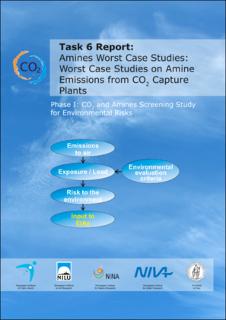| dc.description.abstract | Norway does not currently have any established exposure limits for amines or other hazardous compounds that could be formed in the atmospheric photo-oxidation of amines released from CO2 capture plants. Consequently, in the worst case studies, a number of safety limits for both acute (short-term) and chronic (long-term) toxic/hazardous effects for each of the compound groups (four selected amines and corresponding photo-oxidation products) were introduced. These criteria are based on available lowest/no effect levels in literature recommendations or various international regulations. Following the precautionary principle, the worst case approach sets the strongest toxicological effect (lowest effect level) in relation to the maximum assumed emission. A series of assumptions are made; the most important are 1) no photochemical degradation during transport, 2) no biodegradation in soil and water, 3) no short-term peak emissions. In the model study, degradation products are formed instantaneously after leaving the stack of the CO2 capture plant with a fixed formation yield adopted fromexperimental studies of related alkyl amines. Consequently, the worst case studies rather provide recommendationsto prioritize the problematic compounds and to rank them accordingly with respect to proposed safety limits than accurate predictions of concentration levels or deposition loads. Emissions of amines contribute to the nitrogen load in the atmosphere and could potentially cause eutrophication of sensitive terrestrial ecosystems. The exceedance of a critical load of 5 kg N/ha/yr is known to result in a decline in lichens, mosses, and evergreen shrubs. A worst case scenario revealed that the yearly amine emissions have to be 60 times higher than expected to impose a threat to Norwegian ecosystems. Predicted worst case amine levels for long term exposure are two orders of magnitude below the threshold of 10 μg/m^3 (for MEA). Based on this, long term exposure levels of amine in air that can cause adverse health effects are not exceeded. Toxic compounds produced in the atmospheric oxidation of emitted amines, like nitrosamines, nitramines and amides could be a hazard for ecosystems and human health. Based on a specific US state drinking water standard, the exceedance of the critical load of 7 ng/l nitrosamines in the precipitation to Norwegian lakes would threaten the drinking water quality. Assuming the conversion of 2% of the emitted amine into nitrosamines, the maximum tolerable amine emissions from the plant would be 24 tonnes per year. The inhalation exposure risk of the population to formamide, acetamide, and nitramines could not be assessed in this worst case report due to missing reliable toxicological threshold information. | |
